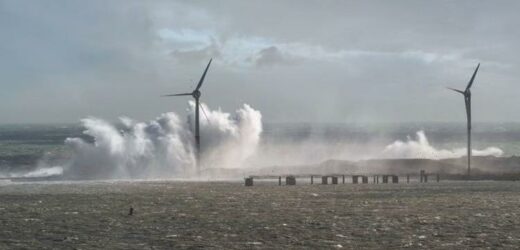Storm Corrie ‘still packing a punch’ says Kirkwood
We use your sign-up to provide content in ways you’ve consented to and to improve our understanding of you. This may include adverts from us and 3rd parties based on our understanding. You can unsubscribe at any time. More info
Windfarms in the UK generated a record amount of renewable electricity over the weekend as parts of Scotland and northern England were struck by Storm Malik. According to data from the National Grid, wind speeds of up to 100 miles an hour were recorded in Scotland. This helped windfarms generate a provisional all-time high of more than 19,500 megawatts of electricity – or more than half the UK’s supply.
The National Grid tweeted: “Today saw the most wind ever on GB’s electricity system with a provisional record of 19.5GW of wind power.
“Although we recognise this milestone on the way to a zero-carbon future, we’re also thinking of those affected by Storm Malik.”
Even as Storm Malik has plunged tens of thousands of people throughout Scotland into darkness as destructive winds topped 100mph – Storm Corrie is set to smash into the UK with the Met Office issuing a “danger to life” warning.
Power companies have said around 34,000 customers are still without power across the north of England and Scotland.


North of the border, Scottish and Southern Electricity Networks (SSEN) has warned attempts to reconnect those customers would be “likely to extend across multiple days” with customers being told to consider making “alternative arrangements”.
Many of the places that were affected by Storm Malik were also battered by Storm Arwen last December, which resulted in the most severe power supply disruption since 2005.
Storm Arwen left almost a million homes in the UK without power for up to 12 days.
The winter storms arrived after a summer of low wind power generation across the UK and Europe, causing an increased use of gas power plants during a global supply shortfall.

Combined with a global bounce back from the COVID-19 pandemic and threats from the Russia-Ukraine conflict, gas prices around the world hit record highs over the past year.
Experts have warned that two million households could be pushed into debt as they struggle to pay soaring energy bills amid rising inflation.
The energy regulator is set to increase the price cap next month to take effect in April.
If the energy price cap rises from £1,277 to £2,000 from April, as is being predicted, monthly bills would increase by £60.25. But the average person can only afford £33.90.
DON’T MISS:
EU fury: Nations fed up with bloc bureaucracy [INSIGHT]
Archaeologists stunned by ‘mystical’ UK cave filled with human bones [REVEALED]
Musk tipped to build Tesla factory in UK after Lithium stores found [SPOTLIGHT]


People already in fuel poverty – those who pay 10 percent or more of their household income on energy – say they can only afford an additional £13.70.
This surge in wind power generation led to a drop in gas prices, as the UK was temporarily relieved from heavily relying on fossil fuels.
The cost for electricity on Saturday fell to £150.59 pounds per megawatt-hour, which was the lowest level seen since 3 January.
Source: Read Full Article


